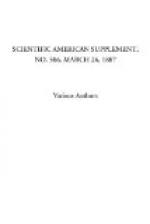By H.N. WARREN, Research Analyst.
On the same principle that electro-dissolution is used for the estimation of combined carbon in steel, etc., I have lately varied the experiment by introducing, instead of steel, iron containing a certain percentage of boron, and, having connected the respective boride with the positive pole of a powerful battery, and to the negative a plate of platinum, using as a solvent dilute sulphuric acid, I observed, after the lapse of about twelve hours, the iron had entirely passed into solution, and a considerable amount of brownish precipitate had collected at the bottom of the vessel, intercepted by flakes of graphite and carbon; the precipitate, having been collected on a filter paper, washed, and dried, on examination proved to be amorphous boron, containing graphite and other impurities, which had become chemically introduced during the preparation of the boron compound. The boron was next introduced into a small clay crucible, and intensely heated in a current of hydrogen gas, for the purpose of rendering it more dense and destroying its pyrophoric properties, and was lastly introduced into a combustion tubing, heated to bright redness, and a stream of dry carbonic anhydride passed over it, in order to separate the carbon, finally pure boron being obtained.
In like manner silicon-eisen, containing 9 per cent. of silicon, was treated, but not giving so satisfactory a result. A small quantity only of silicon separates in the uncombined form, the greater quantity separating in the form of silica, SiO_{2}, the amorphous silicon so obtained apparently being more prone to oxidation than the boron so obtained.
Ferrous sulphide was next similarly treated, and gave, after the lapse of a few hours, a copious blackish precipitation of sulphur, and possessing properties similar to the sulphur obtained by dissolving sulphides such as cupric sulphide in dilute nitric acid, in all other respects resembling common sulphur.
Phosphides of iron, zinc, etc., were next introduced, and gave, besides carbon and other impurities, a residue containing a large percentage of phosphorus, which differed from ordinary phosphorus with respect to its insolubility in carbon disulphide, and which resembled the reaction in the case with silicon-eisen rather than that of the boron compound, insomuch that a large quantity of the phosphorus had passed into solution.
A rod of impure copper, containing arsenic, iron, zinc, and other impurities, was next substituted, using hydrochloric acid as a solvent in place of sulphuric acid. In the course of a day the copper had entirely dissolved and precipitated itself on the negative electrode, the impurities remaining in solution. The copper, after having been washed, dried, and weighed, gave identical results with regard to percentage with a careful gravimetric estimation. I have lately used this method, and obtained excellent results with




